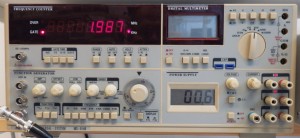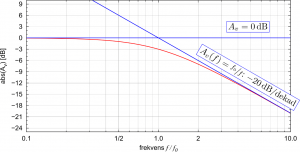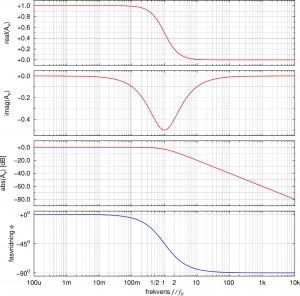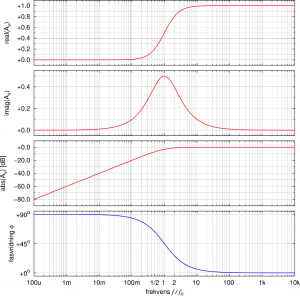PISA – what’s wrong with Sweden
The Swedish education system used to be a good example, but looking at the new PISA results, Sweden is among the countries with the strongest deterioration in school education in reading, mathematics and science. The only thing Sweden has achieved is to narrow the gap between top and low performers – obviously by lowering the overall average.
It is also notable that in spite of worse performance the belief of the students in their abilities is increasing in Sweden.
I cannot say that I am completely surprised by these findings…
(Internal server error? – Try again in a second, the PISA server appears to be heavily loaded right now.)
MOSFETs – what the datasheet doesn’t tell you
[latexpage] I am planning to construct a logarithmic current meter and were yesterday doing some simulations with LTspice. Using a logarithmic converter you can span a wide range of currents…
Pandora’s Promise (The movie)
Yesterday I had the opportunity to watch a screening of the movie Pandora's Promise at Uppsala University. After the movie there was a panel debate including the director of the…
Repairing a Samsung Syncmaster 913TM
I recently got hold of another broken Samsung monitor. This time it is a Syncmaster 913TM which is characterized by its swiveling stand, which allows the screen to be rotated…
Notes from the student lab
Every place in our course laboratory is equipped with an analog oscillsocpe and a Metex Universal System. This instrument consists of a power supply with two fixed and a variable outpur voltage, a multimeter, a function generator and a frequency counter. This sounds nice and it usually is – most of the time the instrument works satisfyingly for our experiments, but there are some disadvantages and most of all it’s not student proof.

First there are several models with somewhat different features – mostly it is the frequency counter and the multimeter which differe between models. The apparently newest series is equipped with green LED displays which are impossible to read, because the company Metex was cheap on a green filter in front of the display. We solved this issue in our lab with pieces of green plastic foil – at a cost of practically nothing, but it makes you wonder if any engineer from Metex has ever been trying to sit in front of the instrument.
Then there is the multimeter. The whole instrument is connected to the power line and its functions powered from internal power supplies – everything but the multimeter. That one is powered by a 9V-battery which is located inaccessibly on the back of the instrument. I thought I knew the reason and assumed the multimeter was based in the standard voltmeter circuit ICL7106 which has the disadvantage that it cannot measure with reference to its own ground potential. The simple way would then have been to just move the whole circuitry from a handheld multimeter (and Metex has become a big company just by making these kinds of multimeters) into the big box, including the battery. The other possibility would have been to use a dc/dc converter which would have added a cost of a few dollars.
As I wrote, I thought I knew. But no… According to the Service Manual the internal multimeter is based on a MAX134 which is well capable of measuring with reference to its own ground potential, and as another matter of fact the display of the built-in power supply is based on the ICL7106 which is powered from a separate winding of the transformer. So WHY?
Finally to today’s problem which triggered this post. One student group ran into problems when they connected their function generator to their self-built transistor amplifier. Just when they connected the function generator the sine curve on the oscilloscope showing the output of the function generator flatlined: But they were sure that their amplifier circuit was ok -after all, that’s what they built themselves… With 20 other groups in the lab at the same time they took the function generator (a 20kg box) from the unoccupied neighboring place and connected it up – and it showed the same misbehavior – what a stupid course lab with all this broken equipment. Before they got to the third function generator I came by – they told me of their problems with the broken equipment, but I became suspicious that there should be such an assembly of broken equipment in just this corner of the lab. I checked their circuit, which connected the +15V supply of the transistor directly to its input and from there of course into the output of the function generator. The broken ones actually smelled slightly badly from their ventilation openings…
If Metex had included a fuse in the output of the function generator it could have been student proof – now I wonder if we can add this feature by ourselves and upgrade these instruments. (more…)
About filters and cut-off frequencies
A good question was brought up by my students in the lab exercise in the course Electronics I yesterday: What actually makes the cut-off frequency of a filter circuit (1st order) so special? Why do we look out for a point which happens to be located ![]() or a factor of
or a factor of ![]() under the amplitude of the pass band? Why not
under the amplitude of the pass band? Why not ![]() ,
, ![]() ,
, ![]() ?
?
The first answer, which has some historical relevance, would be to look at a resistor ![]() and a signal with an amplitude
and a signal with an amplitude ![]() and another signal with an amplitude
and another signal with an amplitude ![]() while calculating the electrical power:
while calculating the electrical power:
[ P_0 = frac{V_0^2}{R}qquad P_1 = frac{V_1^2}{R} = frac{left(V_0,sfrac{1}{sqrt{2}}right)^2}{R} = frac{1}{2},P_0 ]
The power has been reduced to half the original power, it could be the electric power which is converted to sound waves in a speaker, or the power converted to electromagnetic waves in an antenna.
But already here we can make one important observation: ![]()
Is this everything then? It still sounds random to choose exactly this point. If we for example look at a simple RC filter then we can show another reason which makes this point’s frequency so special. In a low-pass filter we have a constant amplitude ![]() for low frequencies while we observed mathematically and experimentally that the amplitude drops with
for low frequencies while we observed mathematically and experimentally that the amplitude drops with ![]() per decade of frequency for high frequencies. If we draw out these two asymptotic lines in a Bode diagram, then we will find exactly one point where the lines intersect – you guessed it: it’s at the cut-off frequency (the same holds of course true for a high-pass filter). We can see this if we zoom into the area around the cut-off frequency in a Bode diagram:
per decade of frequency for high frequencies. If we draw out these two asymptotic lines in a Bode diagram, then we will find exactly one point where the lines intersect – you guessed it: it’s at the cut-off frequency (the same holds of course true for a high-pass filter). We can see this if we zoom into the area around the cut-off frequency in a Bode diagram:

Then was this everything now? Is there more about the cut-off frequency?
As we also saw we have a phase angle of ![]() (high-pass) or
(high-pass) or ![]() (low-pass) between the input- and the output signal at the cut-off frequency. In the complex notation of the
(low-pass) between the input- and the output signal at the cut-off frequency. In the complex notation of the ![]() -method this correlates to the fact that the real and the imaginary part of the transfer function
-method this correlates to the fact that the real and the imaginary part of the transfer function ![]() have the same magnitude at this point. The relation between real part, imaginary part, amplitude and phase angle I have plotted below for both the low-pass and the high-pass filter.
have the same magnitude at this point. The relation between real part, imaginary part, amplitude and phase angle I have plotted below for both the low-pass and the high-pass filter.
It is interesting to observe that the imaginary part actually reaches a minimum at this point (![]() for the low-pass filter) or a maximum (
for the low-pass filter) or a maximum (![]() for the high-pass filter), respectively.
for the high-pass filter), respectively.
You can see that the cut-off frequency actually is a remarkable point for a filter circuit.
Low-pass filter

High-pass filter

Time for a new power tool
About 9 1/2 years, two moves and renovating one kitchen – this is how long I was able to enjoy my power tool “Alpha Tools BAS 14,4-1” from Bauhaus. I guess that’s even more than I could have expected from such a no-name – oh, sorry, let’s call it no-brand tool. But now the battery has reached the end of its lifetime.

At first I tried to just get the battery replaced. But after such a long time it appears impossible to get a new battery pack. Even if I would buy the 12 sub-C cells inside the battery pack directly from China over the internet I would pay more than for a comparable new power tool at one of the local hardware stores.
After realizing this fact I spend a couple of days browsing the selection of the local stores Bauhaus, ClasOhlson, Biltema and Jula. I finally decided to go for a new 18V lithium-ion powered tool from Jula’s own label Meec – i.e. another no-name product. I hope it will serve me well for the next 9 years, but who knows…


On the label of the old power tool even the name and address of the original manufacturer is given – a medium-sized company in Germany. The new tool – as expected – tells you that it was made in China.
And apart from the battery pack I will not throw away the remainders of my old power tool. I can imagine a couple of uses for a strong motor with gear box and a variable chuck.
(more…)
Dark Samsung?
Ever seen a seemingly ok, quite new 24″ Syncmaster SA300 LCD monitor from Samsung – which refuses to show an image, but can display its own system messages?
Try a firmware update! I found this solution in the PC Help Forum.
A firmware update for a computer monitor you wonder? Yes! Obviously you need a second working screen on your system, e.g. you can connect the Syncmaster as a second screen to your laptop. You then download an executable program from Samsung’s homepage and run it. The program will tell you not to switch off the monitor or disconnect the cable while it moves the new firmware over the VGA cable onto the monitor. During this update the animated error message on the monitor will freeze and at the end the monitor will switch itself off.
Now comes the exciting moment – switching the monitor on: will it work…. Well in my case it did! Showing the cloned copy of my laptop screen.
Small sidenote: of course I had first disassembled the monitor, but I couldn’t find a trace of an electronics fault inside… (more…)
Resistance is futile
...at least if you don't know which resistors you have in stock and where they are. For a long time we kept resistors in their original cardboard boxes In our…







